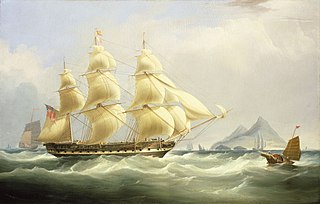
HMS Eclipse was a Royal Navy Cruizer-class brig-sloop built by John King at Dover and launched in 1807. She served off Portugal and then in the Indian Ocean at the capture of the Île de France. Shortly thereafter she captured Tamatave. She was sold for mercantile service in 1815. She traded with India until 1823. Then between 1823 and 1845 she made seven voyages as a whaler.
A number of ships have been named Friendship:
Numerous ships with the name Phoenix, for the constellation or the mythical bird, have sailed for the British East India Company (EIC) between 1680 and 1821:
Numerous vessels have borne the name Coromandel, named for the Coromandel Coast.

A number of ships with the name Asia served the British East India Company (EIC) as East Indiamen:
Numerous British vessels that have served the British East India Company (EIC) have borne the name Prince of Wales, after the then current Prince of Wales, the title borne by the heir-presumptive to the throne of the United Kingdom.
A number of sailing ships have been named Eliza.
Several vessels have been named Harriet, or Harriot:
Several vessels have borne the name Kitty, a diminutive for the name "Catherine", and a name in its own right:

Porcher was launched in 1799 at Calcutta. She made one voyage for the British East India Company (EIC) from Bengal to England. A French privateer captured her in 1802, which gave rise to a case in French courts about the validity of the capture given the impending Treaty of Amiens. The French courts condemned her in prize and new owners in Bordeaux named her Ville de Bordeaux. The British recaptured her in 1804. Thereafter she traded between England and India as a licensed ship. In 1809 she sailed to England where in 1810 new owners renamed her Cambridge. As Cambridge she made three voyages for the EIC as an extra ship. In 1818 she was again sold with her new owners continuing to sail her to the Far East as a licensed ship. She then made two more voyages to India for the EIC. In 1840 she was sold to an American trading house at Canton, and then to the Qing Dynasty, which purchased her for the Imperial Chinese Navy. The British Royal Navy destroyed her on 27 February 1841 during the Battle of First Bar at the onset of the First Opium War.
Georgiana was launched in 1791. She served as a merchantman, packet ship for the British East India Company (EIC), a whaler, a warship of the navy of the United States of America, and a merchant vessel again. She was condemned in 1818 as leaky and sold.
Harleston was an American vessel launched in 1810 at Wiscasset, Maine, and taken in prize. Mestaer purchased her c.1813, and she became a West Indiaman until she was sold on Mestaer's death. She became a whaler and on her way home from her second whaling voyage was condemned in 1826 at Mauritius as unseaworthy and broken up.
Lord Forbes was launched at Chester in 1803 as a West Indiaman. She soon became an "armed defense ship", but by 1805 had returned to being a West Indiaman. She made two voyages as an "extra" ship for the British East India Company (EIC). She continued trading with India until 1817 when she sustained damage on her way to Bengal. There she was surveyed, condemned and sold.
Norfolk was built in France in 1784 under a different name. The British captured her c. 1800 and she made some voyages as a West Indiaman. She also made a cruise as a privateer. Between 1803 and 1808 she served the Royal Navy as an armed defense and hired armed ship on the Leith Station. She spent her time escorting convoys in the North Sea and captured one French privateer. After her naval service, between 1808 and 1814 Norfolk was a London-based transport. From 1814 to 1820 she made four voyages as a whaler in the Southern Whale Fishery. She was last listed in 1823.
Sarah was launched at Hartlepool in 1800. Between 1807 and 1813 Sarah made two voyages as a whaler. As she was coming home from her first whaling voyage a French privateer captured her, but a British privateer recaptured her. After her whaling voyages Sarah became a transport, a West Indiaman, and traded with North America. She was last listed in 1826.
Several vessels have been named Recovery:
Brook Watson was launched in 1796, probably in Holland but possibly in Denmark. She became a prize in 1801 and by 1802 was a whaler in the British Southern Whale Fishery. She made two whaling voyages between 1802 and 1806. She then became a West Indiaman and was last listed in 1809 or 1810.
Cicero was launched at Sunderland in 1796 and initially sailed as a West Indiaman. She was briefly captured in 1799 in a single-ship action with a French privateer. Later, she went whale hunting both in the Northern Whale Fishery (1803-1808), and the Southern Whale Fishery (1816-1823). She capsized at Limerick in September 1832 and was condemned there.
This page is based on this
Wikipedia article Text is available under the
CC BY-SA 4.0 license; additional terms may apply.
Images, videos and audio are available under their respective licenses.


